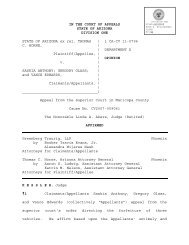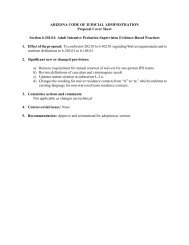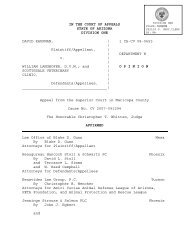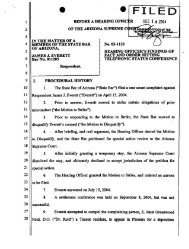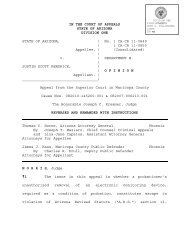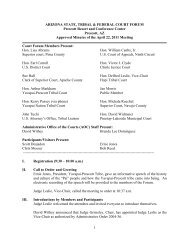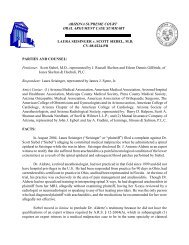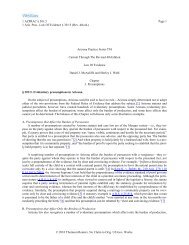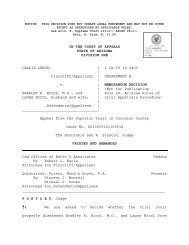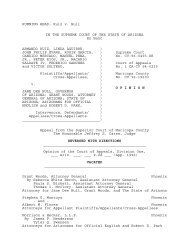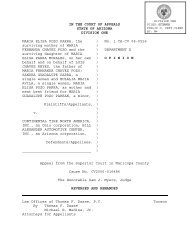Print Version - Arizona Judicial Department
Print Version - Arizona Judicial Department
Print Version - Arizona Judicial Department
Create successful ePaper yourself
Turn your PDF publications into a flip-book with our unique Google optimized e-Paper software.
Having built a robust infrastructure and key “back-office” functions, <strong>Arizona</strong> court<br />
automation continues making major improvements through implementation of “second<br />
generation” automated systems, continuing the journey to exploit process efficiencies<br />
and economies of scale to better serve citizens.<br />
At the state level, the supporting infrastructure includes the <strong>Arizona</strong> <strong>Judicial</strong><br />
Information Network (AJIN), various database and application servers, and the<br />
attached PCs with desktop software.<br />
Back-office functions at the state level include the limited and general jurisdiction<br />
case, cash, jury, juvenile and adult probation and other record management<br />
systems statewide, email, Internet/Intranet access, and the central data<br />
repositories that support public access, statistical reporting, and analysis.<br />
For larger courts, especially those jurisdictions having their own self-contained<br />
tracking systems, back-office functions include continued maintenance,<br />
enhancement, and development of local systems, networks, and desktop<br />
environments.<br />
Maintaining, operating, and enhancing this infrastructure and back-office functionality<br />
remains a priority to allow courts to keep better records, perform case management<br />
functions more efficiently and effectively, and promote greater accountability. Some of<br />
these back-office applications have reached the end of their useful life and require<br />
replacement. A continued focus in this plan is to replace those systems and expand<br />
from back office to front office automation while increasing public access to justicerelated<br />
information.<br />
<strong>Arizona</strong> courts will continue to improve their business practices, especially ones to<br />
better serve the participants in the judicial process, including law enforcement, the legal<br />
community, jury members, victims, self-represented litigants, the media, and the public<br />
at large. To that end, the <strong>Arizona</strong> <strong>Judicial</strong> Branch Information Technology Strategic<br />
Plan: 2013-2015aligns with the judiciary’s business goals found in the <strong>Arizona</strong> <strong>Judicial</strong><br />
publication Justice 20/20: A Vision of the Future of the <strong>Arizona</strong> <strong>Judicial</strong> Branch 2010-<br />
2015, which defines its vision for connecting with and protecting the community.<br />
SERVING THE PUBLIC<br />
Public safety remains a key governing principle that directs automation. Where more<br />
complete and timely information is available on criminals, the public is better served.<br />
Integration of justice information, especially among criminal justice agencies, supports<br />
this goal. The courts continue working for better, closer and more automated interaction<br />
with law enforcement, the <strong>Department</strong> of Corrections, prosecution and defense<br />
agencies, as well as social services agencies, integrating with those systems to the<br />
extent possible. Criminal justice agencies are able to respond in the best interests of<br />
the public when they have ready access to juvenile and adult probation information,<br />
orders of protection, arrest information and pending DUI cases. The courts have been<br />
building their processes and infrastructure to record this information electronically and<br />
ARIZONA JUDICIAL BRANCH | INFORMATION TECHNOLOGY STRATEGIC PLAN: 2013-2015 2




